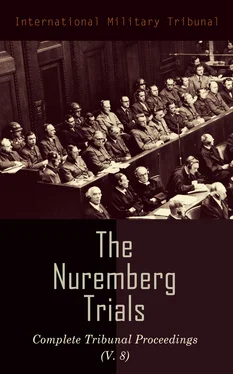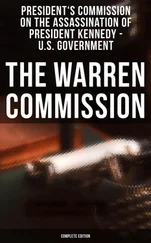“Article 9 of this proclamation fixes an obligatory rate of exchange of 20 Yugoslav dinars for 1 German mark. Thus the value of the dinar in relation to the Reichsmark was artificially and by force lowered. The real rate of exchange before the war was much more favorable to the Yugoslav currency.
“This proves clearly the violation of the appropriate regulations of the Hague Convention, as well as the existence of a plan prepared in advance for the depreciation of Yugoslav currency.”
I submit to the Tribunal a certified photographic copy of the aforementioned proclamation as Exhibit Number USSR-140 (Document Number USSR-140).
“The second predatory measure in the field of currency policy was the introduction of German bonds (Reichskreditkassenschein) as an obligatory means of payment in the occupied territory of Yugoslavia. This measure was also mentioned in Paragraph IX of the proclamation submitted to the Tribunal as Exhibit Number USSR-140. These so-called occupation marks, which were without any economic foundation and without any value whatsoever in Germany itself, were printed in Yugoslavia in accordance with the needs of the German forces of occupation and authorities and in this way served as a means for enabling them to make purchases at a very low price.
“On 30 June 1942”—that is to say, more than a year later—“these Reich bonds were withdrawn. This took place after the Germans had already bought up almost everything that could be purchased in Yugoslavia, and the Yugoslav State Bank had been liquidated and all its properties plundered. In its stead the Germans created the so-called Serbian National Bank.
“However, so that the Germans would suffer no loss through this measure, the Serbian National Bank was forced to exchange the so-called occupation marks for new dinars. The marks thus exchanged were simply withdrawn from the Serbian National Bank by the Germans against receipt. In this way one of the most shameless plunders was carried out, which cost Yugoslavia many thousands of millions of dinars.”
I submit to the Tribunal as Exhibit Number USSR-194 (Document Number USSR-194), “the German decree of 30 June 1942 concerning the withdrawal of notes issued by the Reichskreditkasse and also a certified copy of the decree concerning the Serbian National Bank, of 29 May 1941,” as Exhibit Number USSR-135 (Document Number USSR-135).
“It can be seen from these documents that the German occupation authorities carried out by force the illegal liquidation of the Yugoslav State Bank, under the pretext that Yugoslavia no longer existed, and that they took advantage of this liquidation in order to plunder the country on an enormous scale.
“The Germans established the so-called Serbian National Bank exclusively for the purpose of creating an instrument for their predatory economic and currency policy in Serbia. The bank was administered by officials whom they themselves appointed.
“The measures taken with regard to Yugoslav metal coins are also very characteristic. The Yugoslav coinage, which contained a certain percent of silver and brass, was withdrawn, and replaced by coins of very poor metal alloy. Naturally, the Germans carried to Germany a large quantity of the most valuable Yugoslav coins.
“B. Requisitions and fines.”
The Tribunal will find this excerpt on Page 40 of the document book:
“Reich Minister Speer, head of the Armament and War Production Ministry, declared that fixed prices were the Magna Carta of the Armament Program.”
The Defendant Göring, on 26 March 1943, issued a decree demanding a further decrease in the prices of all goods imported from the occupied countries.
“This lowering of prices was attained by means of currency measures as well as by means of requisitioning, confiscation, fines, and in particular, through a special price policy.
“By means of requisitioning, a policy of fixed low prices, and compulsory sales, the Government of the Reich was enabled to plunder thoroughly the Yugoslav people. This went so far that even the quisling institutions collaborating with the Germans frequently had to declare that the quotas of goods demanded by the Germans could not be filled.
“Thus, a report made by the district chief, for the Moravski District”—quisling administration of Milan Nedic—“on 12 February 1942, stated:
“1. If they are deprived of so many cattle, the peasants will not be able to cultivate their fields. On the one hand, they are ordered to cultivate every inch of ground, on the other hand, their cattle are ruthlessly confiscated.
“2. The cattle are purchased at such a low price that the peasants feel that they are hardly compensated at all for the loss of their cattle.
“Similar examples from other regions or districts of Yugoslavia are very numerous.
“In order to plunder the country, the Germans often reverted to the systematic imposition of money fines. For instance the cash fines imposed by the ‘Feldkommandantur’ in Belgrade during 1943 alone amounted to 48,818,068 dinars. In Nish, during the first 3½ months of 1943, the cash fines amounted to 5,065,000 dinars.
“Finally, we should like to give here a few details regarding the clearing accounts through which the export of Yugoslav goods to Germany was carried out. As early as 1 March 1943 the clearing balance in favor of Serbia amounted to 219 million Reichsmark, or 4,380 million dinars. By the end of the occupation Germany owed Serbia 10,000 million dinars.
“The situation was the same in all the other provinces of Yugoslavia, and only the methods of plundering varied according to local conditions.
“C. Confiscations.
“Confiscations were one of the most widespread and effective means of plundering Yugoslavia.
“Before the occupation of Yugoslavia was completed in 1941, a decree on confiscation was issued by the Germans in the combat zone. Pursuant to this decree the Germans confiscated enormous quantities of agricultural products, raw materials, semi-manufactured, and other goods.”
I submit to the Tribunal a certified copy of the above-mentioned decree as Exhibit Number USSR-206 (Document Number USSR-206).
“Immediately after the occupation of the country, the German occupation authorities introduced by means of numerous decrees, the system of confiscation of private and public property.”
In order to save time I skip a part of this section of the document which quotes concrete examples of the confiscation of property belonging to the Yugoslav population, and I pass on to the next count, which is entitled, “Other Methods of Plunder.” The members of the Tribunal will find this section on Page 52:
“Together with the aforesaid methods of plunder, which were carried out on the basis of various decrees, laws, and regulations, more primitive methods of looting were practiced throughout the Yugoslav territory. They were not sporadic incidents but constituted a part of the German system for enslavement and exploitation.
“The Germans plundered everything from industrial and economic undertakings, down to cattle, food, and even simplest objects for personal use.”
I shall cite a few examples:
“1. Immediately after their entry into Yugoslavia, the Germans looted all the bigger firms and storehouses. They generally engaged in this form of looting at night, after the so-called curfew hours.
“2. The order of Major General Kuebler”—which has already been submitted to the Tribunal by the Soviet Prosecution as Document Number USSR-132—“contains the following passage:
“ ‘Troops must treat these members of the population who maintain an unfriendly attitude toward the occupation forces in a brutal and ruthless manner, depriving the enemy of every means of existence by the destruction of localities which have been abandoned and by seizing all available stocks.’
Читать дальше












